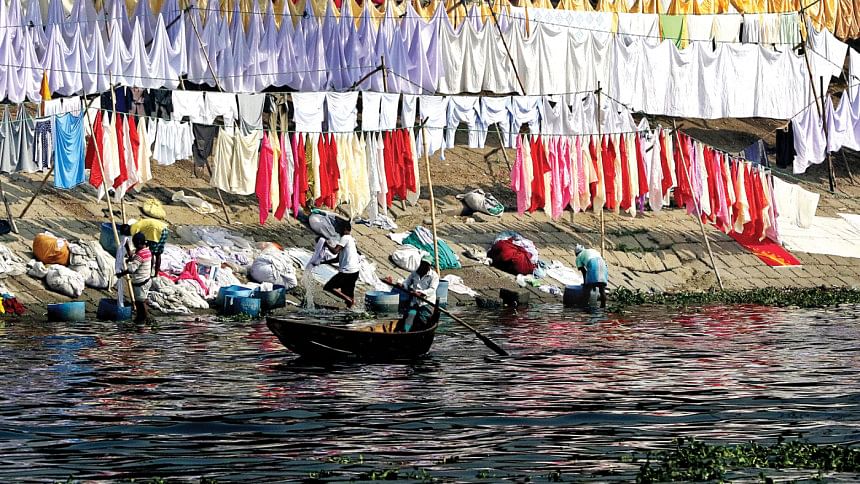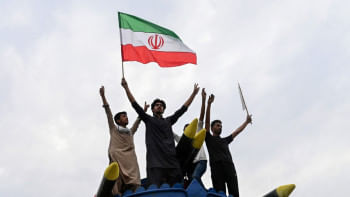Painting a river black


The level of pollutants in the Buriganga water samples taken from some dyeing factory effluent release points is much higher than standard levels, found a study.
Three institutions yesterday jointly released the study on the water quality of the river and the impact of dyeing factories on it.
The three are -- Department of Environmental Science of Stamford University, geography and environment department of Jahangirnagar University and Waterkeepers Bangladesh.
The study found that the pH levels in the water were 7.6, 6.7, and 8.5 in pre-monsoon, monsoon and post-monsoon seasons respectively against the standard level of 7.
The Total Suspended Solids in the water were 108, 57, and 195 per litre against the standard level of 10. The Chemical Oxygen Demand (COD) were 190, 227 and 276 mg per litre against the standard level of 4. The Biological Oxygen Demand (BOD) were 87, 72, 106 mg per litre while the standard is 0.2 mg per litre, said the study.
Dozens of dyeing factories being operated along the five-kilometre stretch of the Buriganga bank from Postogola bridge to Mary Anderson point now appears to be a big hurdle to decontaminate the water as the government relocated more than 100 tanneries to Savar's Hemayetpur in 2017.
Following a High Court order, the Department of Environment early last year snapped water, power, and gas supply connections to at least 50 factories in Shyampur-Kadamtoli area to force them to set up effluent treatment plants (ETPs).
The HC, however, in mid-2021 reinstructed the DoE to restore the connections after the setting up of ETPs.
Sharif Jamil, general secretary of Bangladesh Poribesh Andolon (BAPA), said they hoped there would be a positive impact on the water quality as ETPs were supposed to be installed at dyeing factories.
"But this sadly is not the case. The water quality in the Buriganga is nowhere near the standard level," he told The Daily Star.
Prof Kamruzzaman Majumder of Department of Environmental Science at Stamford University said every parameter of the river water, including COD, TSS, pH, grease and oil, nitrogen and phenol, was found to be well above the standard levels and this may pose a serious threat to human health.
Around 80 to 100 factories release an estimated 60,000 cubic metres of effluents per second into the river partly due to their incapacity and negligence, according to a DoE report released in 2015.
Visiting a stretch of the river from Doleshwar Ghat area to Fire Service Ghat of Shyampur yesterday, this correspondent found factory effluents flowing into the river right under the steps at Doleshwar Ghat.
There was a foul smell in the area which could make anyone feel almost suffocated. The colour of the river water was pinkish in some areas.
Hanif Sharif, senior executive member of BAPA and also an organiser of Buriganga Nodi Morcha, said many who came in contact with the water developed skin diseases.
Underground pipes through which effluents are being released must be snapped, he said, adding that there are around 65 such pipes in Shyampur-Kodomtoli area.
Sharif Jamil of BAPA said as the garment sector is the country's economic backbone, shutting down dyeing factories will not be a solution to this problem.
"The government must ensure that there are cluster ETPs to treat effluents. It must introduce colorgen technology which doesn't emit any effluent for dyeing clothes. Otherwise, the factories will remain as a big hurdle to decontaminate the river water," he observed.
Advocate Manzill Morshed, who filed a writ with the HC in 2015 to stop pollution by dyeing factories, said the court ordered the DoE to snap gas and power links to those factories which didn't have ETP and shut down the underground pipes.
DoE Director (monitoring and enforcement) Mohammad Masud Hasan Patwary said his department last year disconnected power and gas lines to factories without ETP.
He said the court later ordered them to restore the connections as factory owners submitted compliance reports.
The official said they conduct compliance drives on a regular basis.
"We have shut down six dyeing factories and a re-rolling mills in Shyampur. The problem is when we conduct a drive at one factory, the others close theirs. Some factory owners don't run the ETP at times and we know it. We don't have enough manpower to monitor them round the clock," he said.
Azizul Haque, general secretary of Shyampur Dyeing Factory Association, did not receive calls from this correspondent for comments.
However, Mehedi Mokammel, office secretary of the association, claimed they keep ETPs running.

 For all latest news, follow The Daily Star's Google News channel.
For all latest news, follow The Daily Star's Google News channel. 



Comments